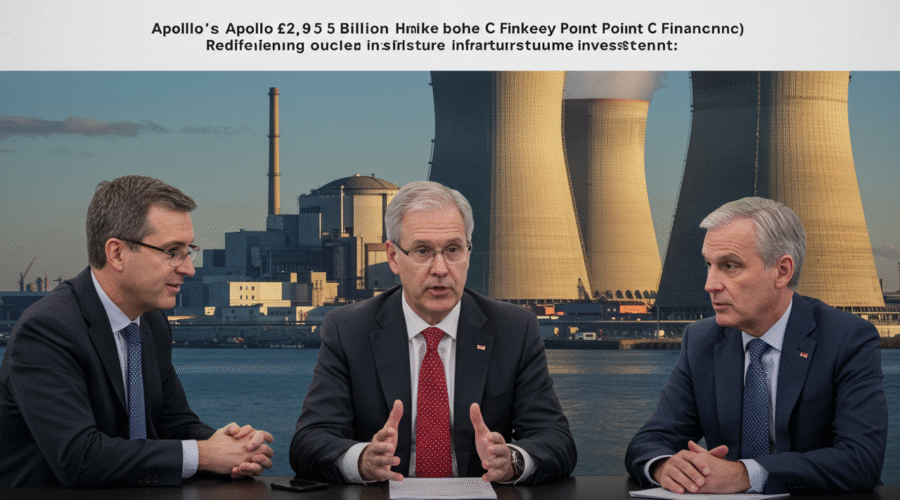In a landmark transaction emblematic of private capital’s strategic pivot toward critical national infrastructure, Apollo Global Management’s £4.5 billion financing package for Électricité de France’s Hinkley Point C nuclear project represents the largest sterling-denominated private credit deal in history[10][12]. This investment-grade debt facility, structured as unsecured notes with a 12-year maximum maturity and priced below 7%[11][9], addresses the £14 billion funding void left by China General Nuclear Power Group’s 2023 withdrawal amid escalating geopolitical tensions[5][4]. The financing secures completion of Europe’s largest energy infrastructure project—now projected at £47.9 billion (2024 prices) with operational delays extending to 2031[1][2]—while establishing a blueprint for private credit’s role in sovereign energy transitions. As Western nations accelerate decarbonization amid supply chain fragility, this transaction signals institutional capital’s readiness to underwrite nuclear renaissance projects combining government-backed revenue streams with inflation-resistant yields[7][13].
💼 Seasoned CorpDev / M&A / PE expertise
The Hinkley Point C Project: A Crucible of Nuclear Ambition
Origins and Strategic Imperatives
Conceived as the cornerstone of the UK’s low-carbon energy transition, Hinkley Point C (HPC) emerged from the British government’s 2008 Nuclear National Policy Statement identifying eight potential sites for new nuclear capacity[1]. The 3.2GW EPR (European Pressurized Reactor) facility in Somerset was designed to generate 7% of the UK’s electricity—sufficient for six million homes—while creating 25,000 jobs during construction and establishing a 60-year operational lifespan[15][18]. The project gained formal approval in 2016 following protracted negotiations, with EDF Energy (66.5%) and China General Nuclear Power Group (33.5%) forming the NNB Generation Company consortium under a groundbreaking Contract for Difference (CfD) guaranteeing £92.50/MWh (2012 prices) for 35 years, inflation-indexed to provide revenue certainty[18][15]. This subsidy mechanism, estimated to cost consumers £30 billion over the contract duration, reflected nuclear power’s non-negotiable position in resolving the energy “trilemma” of security, affordability, and decarbonization despite emerging renewable alternatives[18].
Escalating Challenges and Cost Dynamics
Construction commencement in 2017 initiated a cascade of financial and technical setbacks that transformed HPC into Europe’s most contentious infrastructure project. Original 2015 estimates of £18 billion ballooned to £26 billion by 2022[1], then £31-35 billion (2015 prices) by January 2024—equivalent to £41.6-47.9 billion in current values[1][2]. EDF’s 2024 annual results attributed £800 million in impairments specifically to Hinkley’s revised inflation assumptions[14], while COVID-19 disruptions added 15 months to the timeline alongside Brexit-related supply chain complications[2]. The operational schedule deteriorated from an initial 2025 target to 2027-2029 in 2023[1], then 2029-2031 in 2024[1][2], creating a compound delay exceeding six years. These overruns stemmed from nuclear industry restart complexities after the UK’s 20-year construction hiatus, with EDF managing director Stuart Crooks acknowledging “civil construction slower than we hoped and faced inflation, labour and material shortages”[2]—a perfect storm exposing the vulnerabilities of first-of-a-kind nuclear projects in liberalized energy markets.
Geopolitical Realignment: The CGN Withdrawal and Funding Crisis
Sino-Western Tensions Catalyze Disengagement
China General Nuclear Power Group’s abrupt suspension of funding installments in late 2023[5] crystallized geopolitical fractures that had been widening since the UK government seized CGN’s stake in the Sizewell C nuclear project in 2022 over national security concerns[5][11]. The contractual structure permitted CGN to cease payments upon cost overruns exceeding predetermined thresholds[5], triggering a £14 billion financing gap that threatened project viability. This disengagement reflected broader Western recalibration toward Chinese involvement in critical infrastructure, with Whitehall sources confirming CGN’s planned Bradwell B reactor project had become “politically untenable”[5]. EDF’s 2023 disclosures had anticipated “high probability” of CGN withdrawal[5], but the speed of disengagement left the French utility—already grappling with €54.3 billion net debt and €22.4 billion in 2024 investments[14]—solely responsible for completing Europe’s largest energy project amid soaring domestic nuclear refurbishment costs.
Sovereignty Imperatives Reshape Capital Structures
The funding crisis coincided with heightened European focus on energy autonomy following Russia’s weaponization of gas supplies, transforming Hinkley from mere infrastructure project into a sovereignty imperative. UK Energy Security Secretary Claire Coutinho emphasized in 2024 that “nuclear isn’t optional—it’s existential for baseload security without carbon”[4], while EDF framed completion as essential for “European energy sovereignty”[10]. This geopolitical reprioritization created the political capital for Apollo’s entry, with the deal structure deliberately avoiding equity transfer to maintain state-controlled operational oversight[4][10]. The financing represents a paradigm shift from multinational consortia toward Western-aligned private capital, with Apollo partner Jamshid Ehsani explicitly linking the transaction to “advancing European energy sovereignty”[10]—a rhetorical framing that secured regulatory acquiescence despite the project’s checkered history.
Apollo’s Financing Architecture: Private Credit’s Watershed Moment
Transaction Mechanics and Structural Innovation
Executed under EDF’s €50 billion Euro Medium Term Note (EMTN) program[10], Apollo’s £4.5 billion commitment comprises fixed-rate callable notes issued in three annual tranches of £1.5 billion[11][9], creating staggered liquidity aligned with construction milestones. The unsecured status—unprecedented for nuclear project finance—reflects Apollo’s confidence in EDF’s investment-grade credit profile and the UK government’s CfD backing[7][11]. The below-7% coupon[11][9] compares favorably with EDF’s 2024 corporate bond issuances averaging 5.8-6.3%[14], with the premium compensating for duration risk in a sector where traditional project finance debt rarely exceeds seven years. Crucially, the 12-year maximum maturity[9] bridges the pre-operational phase through initial revenue generation, structured to allow refinancing via institutional markets once operational de-risking occurs.
Risk Allocation and Investor Protections
Apollo mitigated exposure through layered safeguards: First, the CfD’s inflation-indexed £128/MWh floor price (2025 values)[15] creates revenue certainty exceeding 90% of projected output. Second, EDF’s completion guarantee—backed by the French state’s AA credit rating—eliminates technology risk allocation to lenders[7]. Third, the callable feature permits Apollo to exit should credit metrics deteriorate, while step-up provisions protect against duration mismatches in rising rate environments[8]. This structure exemplifies private credit’s evolution toward “bespoke capital solutions” as described in Apollo’s 2025 investor materials[10], contrasting with the syndicated loan market’s standardized covenants. The transaction’s risk-reward profile aligns with Preqin data showing private debt delivering 15.8% three-year returns through 2023[13], outperforming leveraged loans by 200+ basis points despite similar senior secured positioning[8].
Private Credit’s Infrastructure Ascent: From Niche to Core Allocation
Market Evolution and Institutional Adoption
Apollo’s Hinkley financing culminates private credit’s decade-long transformation from distressed debt niche to essential infrastructure funding pillar. UK private debt AUM surged from $15.8 billion in 2008 to $257.9 billion by 2023[13], with 64% of European private debt managed from London[13]. This growth reflects institutional demand for liability-matching assets offering inflation resistance—a demand intensified by 2022-2024 rate hikes that increased private credit’s average spread to 687 basis points over SOFR[8]. Apollo alone has originated over $100 billion in “High-Grade Capital Solutions” since 2020[10], including €2.5 billion for Air France-KLM and $11 billion for Intel’s Ireland fab[10][6]. The Hinkley deal’s scale demonstrates private credit’s capacity to absorb single exposures exceeding traditional project finance markets, with Apollo’s infrastructure co-head Scott Kleinman noting “the $1.5 trillion sector now targets entire capital stacks for critical assets”[7].
Comparative Advantage in Complex Deals
Private credit’s structural flexibility proved decisive for Hinkley’s unique challenges. Traditional project finance requires revenue-generating assets, excluding pre-operational phases[7]. Syndicated loans faced borrower resistance to nuclear-specific covenants. Bond markets demanded prohibitive premiums for 12-year duration. Apollo bridged this gap through bilateral negotiation accommodating EDF’s operational constraints—including grace periods aligning with construction milestones and bespoke reporting metrics[7][11]. This “patient capital” approach, as Apollo terms it[10], reflects the asset class’ core competency in complex situations where public markets fear to tread. The transaction establishes a replicable template for other stalled European projects, from Germany’s grid expansion to Iberian hydrogen backbones, with Apollo president Jim Zelter projecting “$100 billion deployable in German infrastructure alone this decade”[11].
Energy Sovereignty Imperatives: Nuclear’s Resurgent Role
Policy Drivers and Security Economics
Hinkley’s rescue financing coincides with unprecedented European recommitment to nuclear energy as decarbonization and security imperatives converge. The UK’s 2024 Civil Nuclear Roadmap targets 24GW of nuclear capacity by 2050—quadrupling current output to supply 25% of electricity[16]—while France’s “Ambitions 2035” plan commits €22.4 billion annually to nuclear refurbishment[14]. This policy shift recognizes nuclear’s unique ability to provide 90% capacity factor baseload power, contrasting with solar’s 10-25% and offshore wind’s 35-50%[16]. Security economics now explicitly value fuel diversity, with UK Energy Security Secretary Grant Shapps noting “Russian gas taught us that intermittent renewables need firm partners—nuclear is that partner”[4]. Apollo’s investment thesis directly incorporates these sovereign priorities, with partner Jamshid Ehsani stating the deal “finances critical, low-carbon nuclear infrastructure essential for energy independence”[9].
Valuation Metrics in Sovereignty Context
Traditional project finance metrics fail to capture Hinkley’s full value proposition in contemporary energy calculus. While the CfD’s £92.50/MWh (2012 prices) exceeds offshore wind’s £57.50/MWh[18], the security premium now carries explicit economic weight. National Grid’s 2025 Stress Test scenarios value nuclear’s capacity credit at £45/kW
Sources
https://en.wikipedia.org/wiki/Hinkley_Point_C_nuclear_power_station, https://www.world-nuclear-news.org/articles/edf-announces-hinkley-point-c-delay-and-big-rise-i, http://www.caea.gov.cn/english/n6759361/n6759362/c6792856/content.html, https://www.ainvest.com/news/apollo-4-5-billion-stake-hinkley-point-beacon-european-energy-sovereignty-private-credit-role-2506/, https://www.energyconnects.com/news/utilities/2023/december/china-s-cgn-halts-funding-for-uk-s-hinkley-nuclear-plant/, https://en.wikipedia.org/wiki/Apollo_Global_Management, https://www.ainvest.com/news/private-credit-era-apollo-4-5-billion-hinkley-point-deal-infrastructure-shift-2506/, https://www.federalreserve.gov/econres/notes/feds-notes/private-credit-characteristics-and-risks-20240223.html, https://www.upi.com/Top_News/World-News/2025/06/20/Britain-Apollo-loan-Hinckley-nuclear-project/8351750459958/, https://www.apollo.com/insights-news/pressreleases/2025/06/apollo-commits-to-4-5-billion-financing-for-lectricit-de-france-marking-the-largest-sterling-denominated-private-credit-transaction-3102855, https://www.nbcbayarea.com/news/business/money-report/apollo-to-supply-4-5-billion-loan-to-uk-nuclear-project/3897108/, https://www.tradingview.com/news/reuters.com,2025:newsml_FWN3SN049:0-investment-firm-apollo-commits-4-5-bln-stg-to-france-s-edf-which-will-help-finance-hinkley-point-c/, https://www.bvca.co.uk/resource/private-debt-s-steady-rise-in-the-uk.html, https://www.edf.fr/en/the-edf-group/dedicated-sections/journalists/all-press-releases/2024-annual-results, https://www.lowcarboncontracts.uk/resources/guidance-and-publications/hinkley-point-c-cfd/, https://world-nuclear.org/information-library/country-profiles/countries-t-z/united-kingdom, https://theecologist.org/2014/apr/08/hinkley-c-nuclear-subsidy-too-far, https://publications.parliament.uk/pa/cm201719/cmselect/cmpubacc/393/39306.htm, https://www.telegraph.co.uk/business/2017/07/03/hinkley-nuclear-costs-climb-almost-20bn-start-delayed/, https://archive.org/stream/FinancialTimes1979UKEnglish/Apr%2002%201979,%20Financial%20Times,%20%2327830,%20UK%20(en)_djvu.txt





